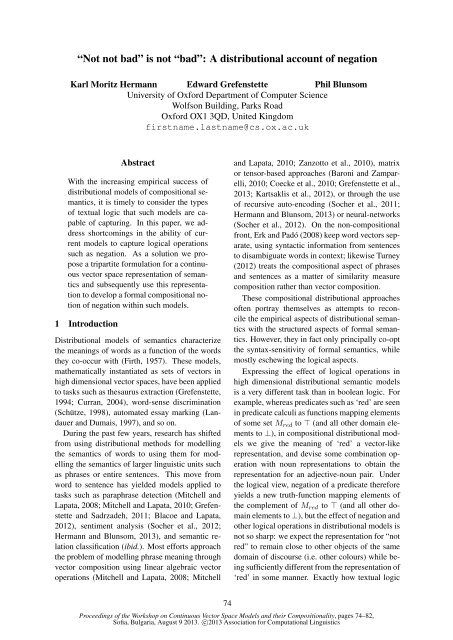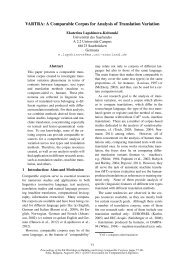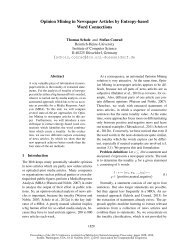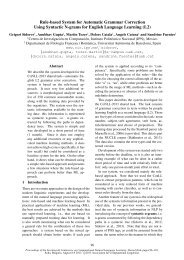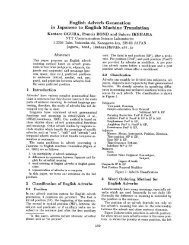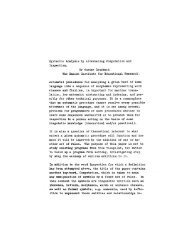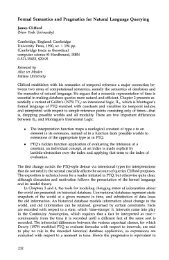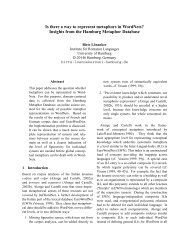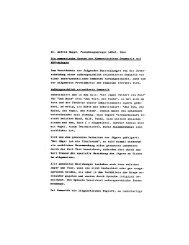Vector Space Semantic Parsing: A Framework for Compositional ...
Vector Space Semantic Parsing: A Framework for Compositional ...
Vector Space Semantic Parsing: A Framework for Compositional ...
You also want an ePaper? Increase the reach of your titles
YUMPU automatically turns print PDFs into web optimized ePapers that Google loves.
“Not not bad” is not “bad”: A distributional account of negation<br />
Karl Moritz Hermann Edward Grefenstette<br />
Phil Blunsom<br />
University of Ox<strong>for</strong>d Department of Computer Science<br />
Wolfson Building, Parks Road<br />
Ox<strong>for</strong>d OX1 3QD, United Kingdom<br />
firstname.lastname@cs.ox.ac.uk<br />
Abstract<br />
With the increasing empirical success of<br />
distributional models of compositional semantics,<br />
it is timely to consider the types<br />
of textual logic that such models are capable<br />
of capturing. In this paper, we address<br />
shortcomings in the ability of current<br />
models to capture logical operations<br />
such as negation. As a solution we propose<br />
a tripartite <strong>for</strong>mulation <strong>for</strong> a continuous<br />
vector space representation of semantics<br />
and subsequently use this representation<br />
to develop a <strong>for</strong>mal compositional notion<br />
of negation within such models.<br />
1 Introduction<br />
Distributional models of semantics characterize<br />
the meanings of words as a function of the words<br />
they co-occur with (Firth, 1957). These models,<br />
mathematically instantiated as sets of vectors in<br />
high dimensional vector spaces, have been applied<br />
to tasks such as thesaurus extraction (Grefenstette,<br />
1994; Curran, 2004), word-sense discrimination<br />
(Schütze, 1998), automated essay marking (Landauer<br />
and Dumais, 1997), and so on.<br />
During the past few years, research has shifted<br />
from using distributional methods <strong>for</strong> modelling<br />
the semantics of words to using them <strong>for</strong> modelling<br />
the semantics of larger linguistic units such<br />
as phrases or entire sentences. This move from<br />
word to sentence has yielded models applied to<br />
tasks such as paraphrase detection (Mitchell and<br />
Lapata, 2008; Mitchell and Lapata, 2010; Grefenstette<br />
and Sadrzadeh, 2011; Blacoe and Lapata,<br />
2012), sentiment analysis (Socher et al., 2012;<br />
Hermann and Blunsom, 2013), and semantic relation<br />
classification (ibid.). Most ef<strong>for</strong>ts approach<br />
the problem of modelling phrase meaning through<br />
vector composition using linear algebraic vector<br />
operations (Mitchell and Lapata, 2008; Mitchell<br />
and Lapata, 2010; Zanzotto et al., 2010), matrix<br />
or tensor-based approaches (Baroni and Zamparelli,<br />
2010; Coecke et al., 2010; Grefenstette et al.,<br />
2013; Kartsaklis et al., 2012), or through the use<br />
of recursive auto-encoding (Socher et al., 2011;<br />
Hermann and Blunsom, 2013) or neural-networks<br />
(Socher et al., 2012). On the non-compositional<br />
front, Erk and Padó (2008) keep word vectors separate,<br />
using syntactic in<strong>for</strong>mation from sentences<br />
to disambiguate words in context; likewise Turney<br />
(2012) treats the compositional aspect of phrases<br />
and sentences as a matter of similarity measure<br />
composition rather than vector composition.<br />
These compositional distributional approaches<br />
often portray themselves as attempts to reconcile<br />
the empirical aspects of distributional semantics<br />
with the structured aspects of <strong>for</strong>mal semantics.<br />
However, they in fact only principally co-opt<br />
the syntax-sensitivity of <strong>for</strong>mal semantics, while<br />
mostly eschewing the logical aspects.<br />
Expressing the effect of logical operations in<br />
high dimensional distributional semantic models<br />
is a very different task than in boolean logic. For<br />
example, whereas predicates such as ‘red’ are seen<br />
in predicate calculi as functions mapping elements<br />
of some set M red to ⊤ (and all other domain elements<br />
to ⊥), in compositional distributional models<br />
we give the meaning of ‘red’ a vector-like<br />
representation, and devise some combination operation<br />
with noun representations to obtain the<br />
representation <strong>for</strong> an adjective-noun pair. Under<br />
the logical view, negation of a predicate there<strong>for</strong>e<br />
yields a new truth-function mapping elements of<br />
the complement of M red to ⊤ (and all other domain<br />
elements to ⊥), but the effect of negation and<br />
other logical operations in distributional models is<br />
not so sharp: we expect the representation <strong>for</strong> “not<br />
red” to remain close to other objects of the same<br />
domain of discourse (i.e. other colours) while being<br />
sufficiently different from the representation of<br />
‘red’ in some manner. Exactly how textual logic<br />
74<br />
Proceedings of the Workshop on Continuous <strong>Vector</strong> <strong>Space</strong> Models and their <strong>Compositional</strong>ity, pages 74–82,<br />
Sofia, Bulgaria, August 9 2013. c○2013 Association <strong>for</strong> Computational Linguistics


